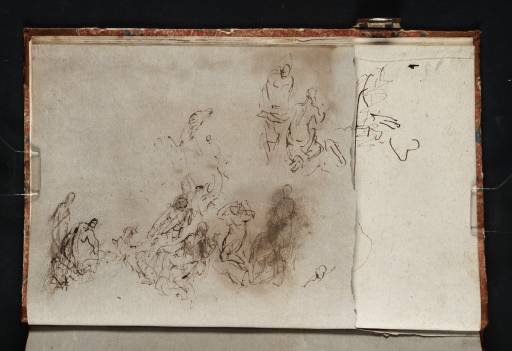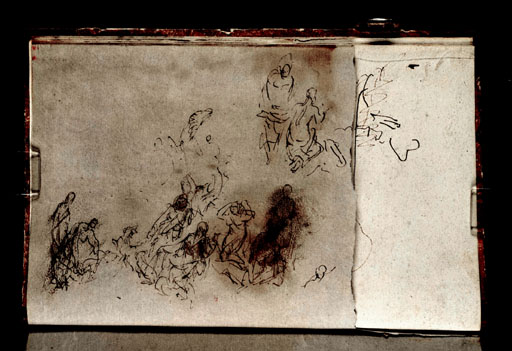Joseph Mallord William Turner Studies for Figures in 'Dido and Aeneas'; and of a Horse, Related to 'The Destruction of Sodom' 1805
Image 1 of 2
Joseph Mallord William Turner,
Studies for Figures in 'Dido and Aeneas'; and of a Horse, Related to 'The Destruction of Sodom'
1805
Joseph Mallord William Turner 1775–1851
Folio 4 Verso:
Studies for Figures in ‘Dido and Aeneas’; and of a Horse, Related to ‘The Destruction of Sodom’ 1805
D05773
Turner Bequest XCIII 4a
Turner Bequest XCIII 4a
Pen and ink and a little brown wash on white wove paper, prepared with a grey wash, 171 x 190 mm
(irregular)
(irregular)
Accepted by the nation as part of the Turner Bequest 1856
Exhibition history
1990
Painting and Poetry: Turner’s ‘Verse Book and his Work of 1804–1812, Tate Gallery, London, June–September 1990 (13).
2002
Turner et le Lorrain, Musée des beaux-arts, Nancy, December 2002–March 2003 (12).
References
1909
A.J. Finberg, A Complete Inventory of the Drawings of the Turner Bequest, London 1909, vol.1, p.242, XCIII 4a.
1984
Martin Butlin and Evelyn Joll, The Paintings of J.M.W. Turner, revised ed., New Haven and London 1984, p.93.
1990
Andrew Wilton and Rosalind Mallord Turner, Painting and Poetry: Turner’s ‘Verse Book’ and his Work of 1804–1812, exhibition catalogue, Tate Gallery, London 1990, p.119 reproduced.
1993
David Hill, Turner on the Thames: River Journeys in the Year 1805, New Haven and London 1993, p.165.
2001
Martin Butlin, ‘Carthage’ in Evelyn Joll, Martin Butlin and Luke Herrmann eds., The Oxford Companion to J.M.W. Turner, Oxford 2001, p.43.
2002
Ian Warrell, Blandine Chavanne and Michael Kitson, Turner et le Lorrain, exhibition catalogue, Musée des beaux-arts, Nancy 2002, p.60 reproduced in colour.
The leaf is torn and reduced in size; see note to the recto (D05772).
Dido and Aeneas (Tate N00494)1 was exhibited at the Royal Academy in 1814 but probably painted earlier. For the picture and subject, see especially catalogue note to the coloured study in the contemporary Studies for Pictures: Isleworth sketchbook (Tate D05520; Turner Bequest XC 21). A further composition study, in pen and wash, is on folio 5 of the present sketchbook (D05774), while further figure studies on folios 5 verso–7 (D05775–D05778) have been associated with the picture since Finberg. Hill goes so far as to say that in this sketchbook ‘the full composition and most of the details are established’ and suggests on this basis that the picture was probably begun in 1805 and perhaps exhibited at Turner’s Gallery in 1806. Warrell notes a possible source for Turner’s subject in the View of Carthage with Dido and Aeneas by Claude Lorrain (Kunsthalle, Hamburg) that had passed through the London art market in 1801; however, as he points out, Turner’s conception of the ancient city is far more elaborate than Claude’s.
Here, a kneeling woman and companion at upper right and figures with hunting dogs at lower left anticipate the picture. At upper left of centre are the beginnings of a sketch of a rearing horse which is developed further, with surrounding figures, on folios 5 and especially 6 verso and 7. Assuming the connection with Dido and Aeneas the motif must be related to the horses which in the picture cross a bridge in the right foreground. Turner painted them as ‘equi effrenati ... without bridles’, and when told by Henry Scott Trimmer that ‘the Libyan horses had no bridles ... said he knew it’.2 The rearing posture of the horses in these drawings and efforts of some of the figures to control them would fit this belief. However, in keeping with its Neoclassical poise, the horses in the picture cross the bridge in an orderly column and instead Turner seems to have used the rearing horse from his drawings in another context, in the centre of The Destruction of Sodom (Tate N00474).3 This connection has not been noticed before and might support the date of ‘about 1805’ first suggested for Sodom by Walter Thornbury, while not necessarily confirming the possibility floated by Butlin and Joll (without evidence as they admit) that it was shown in Turner’s Gallery that year.
David Blayney Brown
October 2007
How to cite
David Blayney Brown, ‘Studies for Figures in ‘Dido and Aeneas’; and of a Horse, Related to ‘The Destruction of Sodom’ 1805 by Joseph Mallord William Turner’, catalogue entry, October 2007, in David Blayney Brown (ed.), J.M.W. Turner: Sketchbooks, Drawings and Watercolours, Tate Research Publication, December 2012, https://www


